From UNESCO recognized cities to quiet seaside villages, Albania has so many amazing places to see. I spent three months traveling around the small, but shockingly beautiful country. One week I was exploring a tiny mountain village in the Accursed Mountains and the next feet up, lounging by the Mediterranean’s luminous turquoise waters.
I saw a ton of brilliant towns and cities, each one with unique sites and friendly people. While I haven’t seen everything Albania has to offer yet, I’d like to share some of the places that made my trip an unbelievable one.
Here is a detailed Albania travel guide to help you pick your next destination.
GETTING AROUND ALBANIA:
Transport in Albania is overwhelming at the best of times and downright chaotic almost all the time. Most visitors will end up using a range of travel options, including car rentals, furgons (local buses), and long-distance buses.
By Car | Car rentals are easy, cheap, and a great option for exploring the hard-to-get places in the country. However, the roads can be hectic, and road conditions could be better in some areas. If you’re renting, make sure to get car insurance and drive cautiously.
By Furgon / Bus | This is the option most travelers will choose. While buses go almost everywhere in Albania, they are most definitely disorganized. But, they’re still a great way to explore the country. If you want to learn more about the bus system, popular routes, and timetables, you can have a look at my Albania Bus Guide article.
Tours | If you’re heading to Albania on holiday and plan on spending an extended time in one place, a day tour to multiple cities might be your best bet. There are some great options you can find on GetYourGuide and Viator.
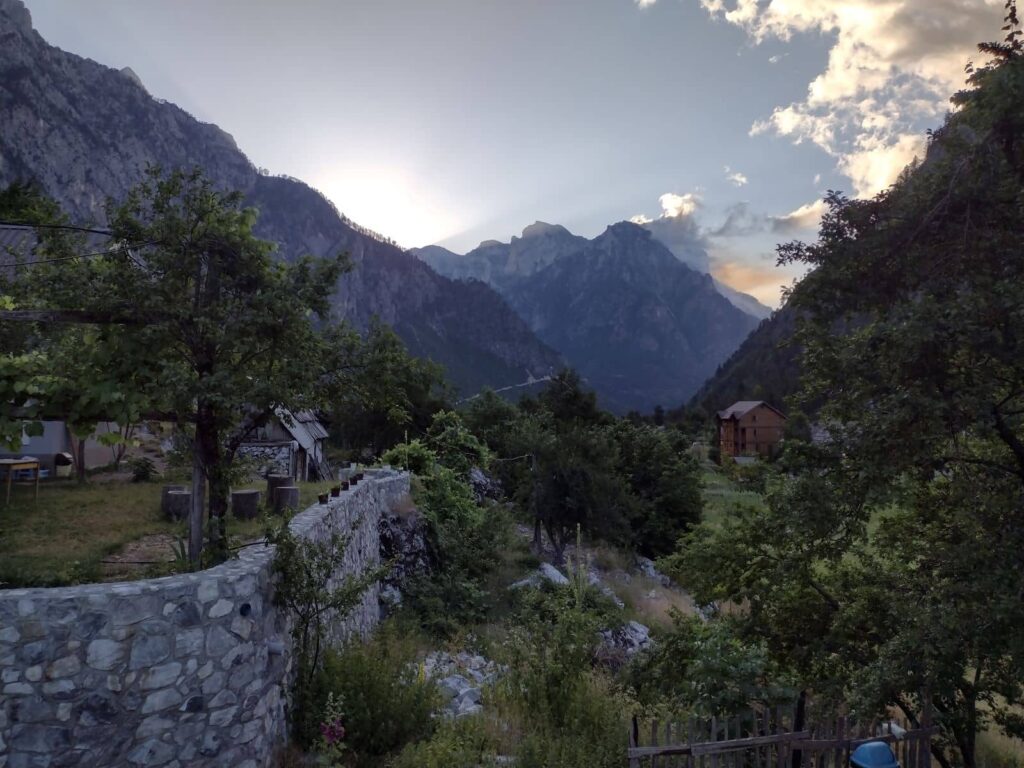
ACCOMMODATION OPTIONS:
Albania has a mixture of bed & breakfasts, short-term apartment rentals, resorts, and boutique hostels. I found the hospitality in most places to be second to none. Most family-run places go out of their way to make your stay an amazing experience!
My partner and I used Booking for just about everything, including our longer apartment stays.
Tirana | Albania's Capital City
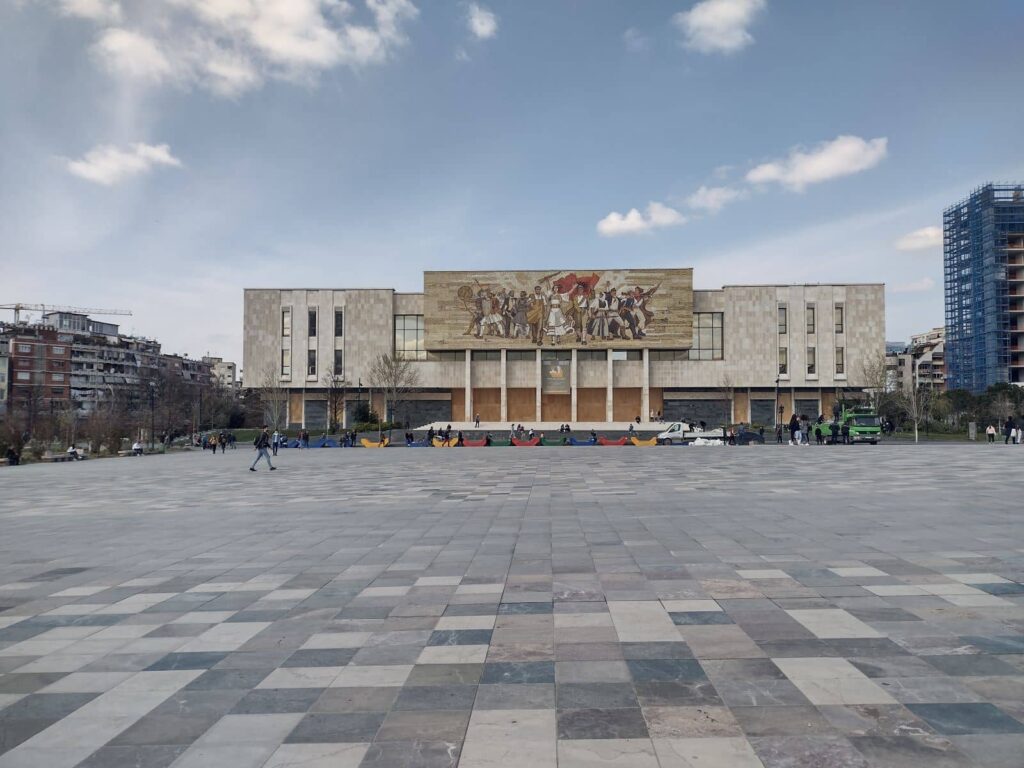
This is an obvious one. But, if you’re popping into Albania from one of the neighboring countries, it’s easy to miss out on the country’s trendy capital city.
For the fast traveler, Tirana is easily explorable by foot in just a couple days. There’s a nice blend of historical sites, modern museums, and nature visits. The slow traveler will enjoy the tremendous amount of cafes, mouth watering food, and exploring the different neighborhoods.
Either way, there will be a few things everyone will want to visit!
My first suggestion is to go on a free walking tour when you arrive. The guides are knowledgeable and fun and they’ll walk you to most of the main historical sites in the city. You’ll start at the impressive Skanderbeg Square and make your way around to some places that are surprisingly rich in history.
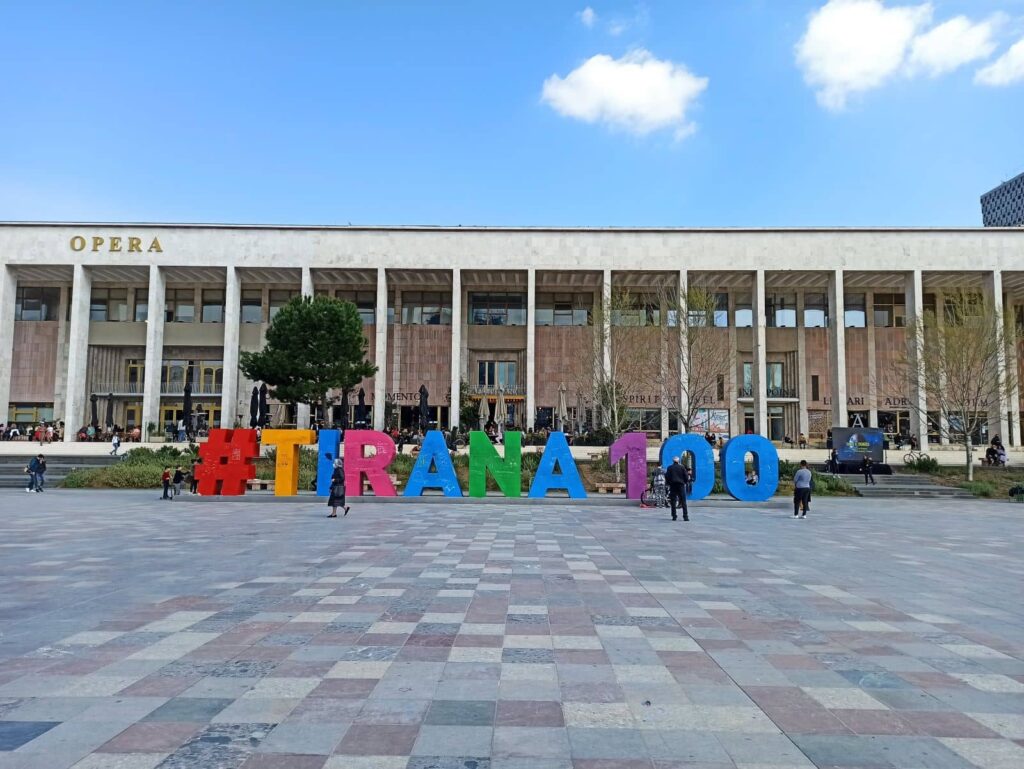
While the guides do a great job at explaining Tirana’s story through the ages, there’s undoubtedly a strong communist era component to the tour. Almost everywhere you go in the country this is the case, but it’s at the forefront in the capital. You’ll see various old statues of Lenin, walk by where the Pyramid of Tirana once stood, and take a peek into the entrance of Bunk’Art 2.
Eventually, you’ll be led through the funky Blloku neighborhood where you’ll see remnants of the Berlin Wall and peak into Enver Hoxha’s former residence.
During the tour, you’ll also see some of the city’s religious buildings, including the spectacular Et’hem Bej Mosque and the impressive Resurrection of Christ Orthodox Cathedral.
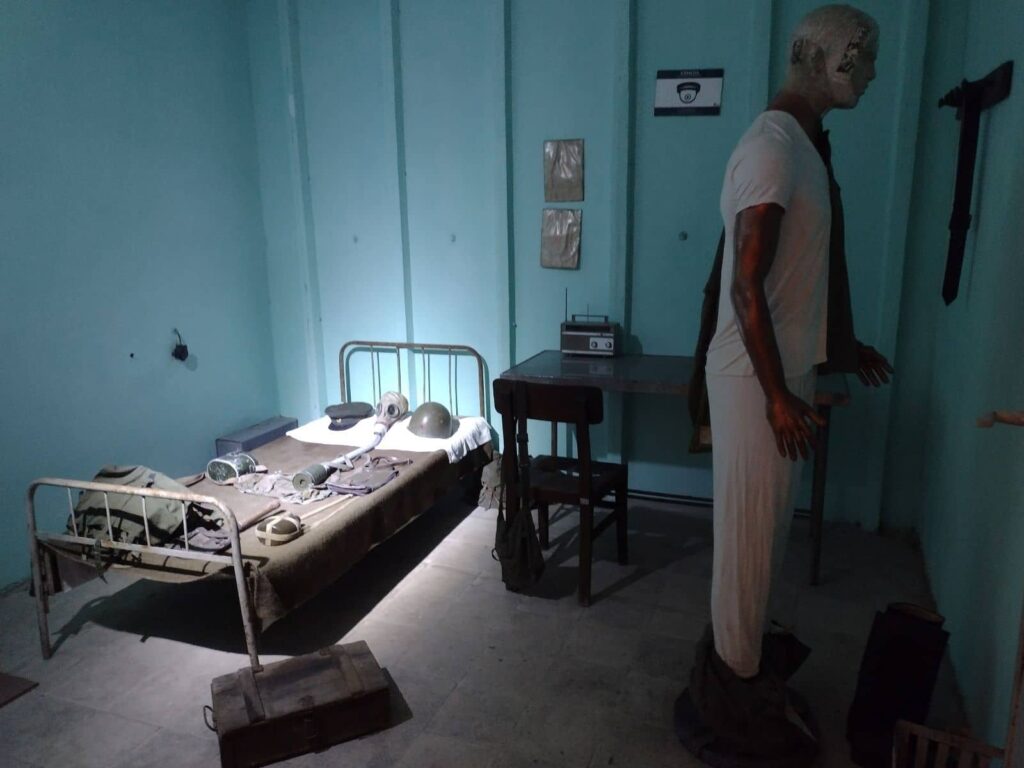
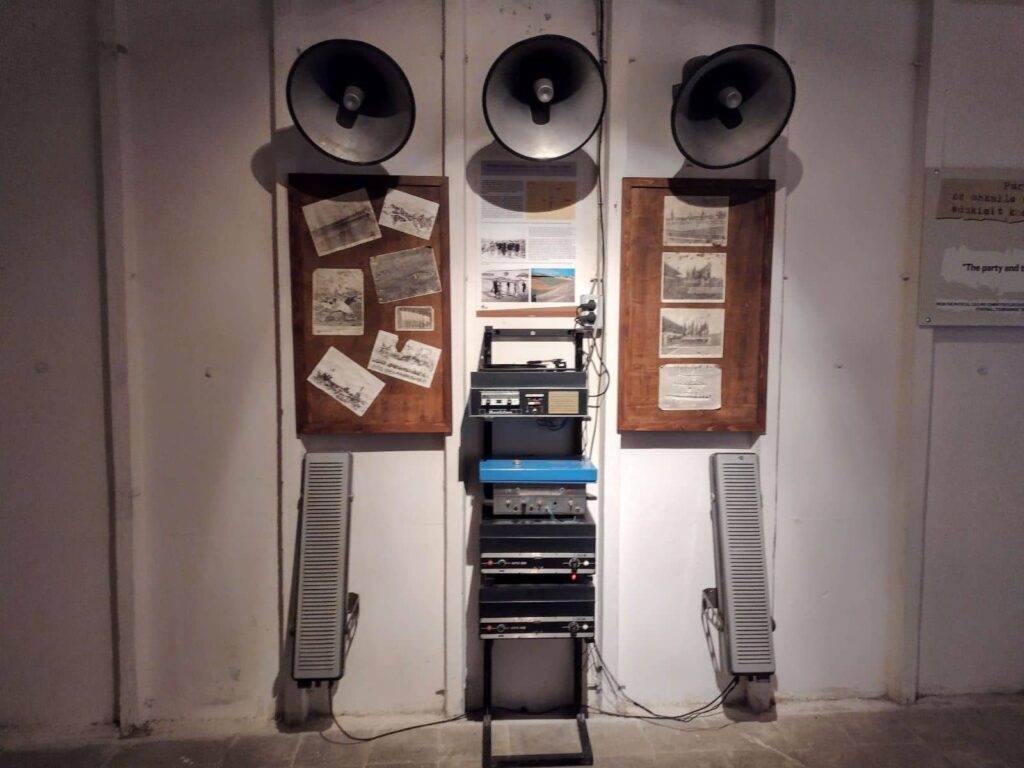
MORE THAN JUST A WALKING TOUR
There are places that a walking tour just can’t get you in Tirana. If you’ve heard about the city before, two things commonly come up in conversation.
The first is the modern and fantastic museum, Bunk’Art 1. I mentioned its sister museum earlier, but this is the original and largest of the two. Bunkers are everywhere in the country and the gallery gives amazing insight into their original purpose and history. Plus, wandering around a large nuclear bunker is just plain cool!
Price | When I was there, entry into the museum was 500 Lek.
The second is a trip up Dajti Mountain on the Dajti Ekspres. The cable car ride is full of breathtaking views of nature to the coast. Once at the top of the mountain, you can enjoy various hiking trails, activities, and a restaurant with a panoramic view.
Return | A return ticket costs 1400 Lek.
When the sightseeing is done, have fun exploring the awesome food scene, talking to the warm Albanian people, and wandering the various neighborhoods.
With its colorful facades and booming coffee scene, Tirana is the perfect place to create a base for your Albania adventures.
Shkoder | The Gateway to the North
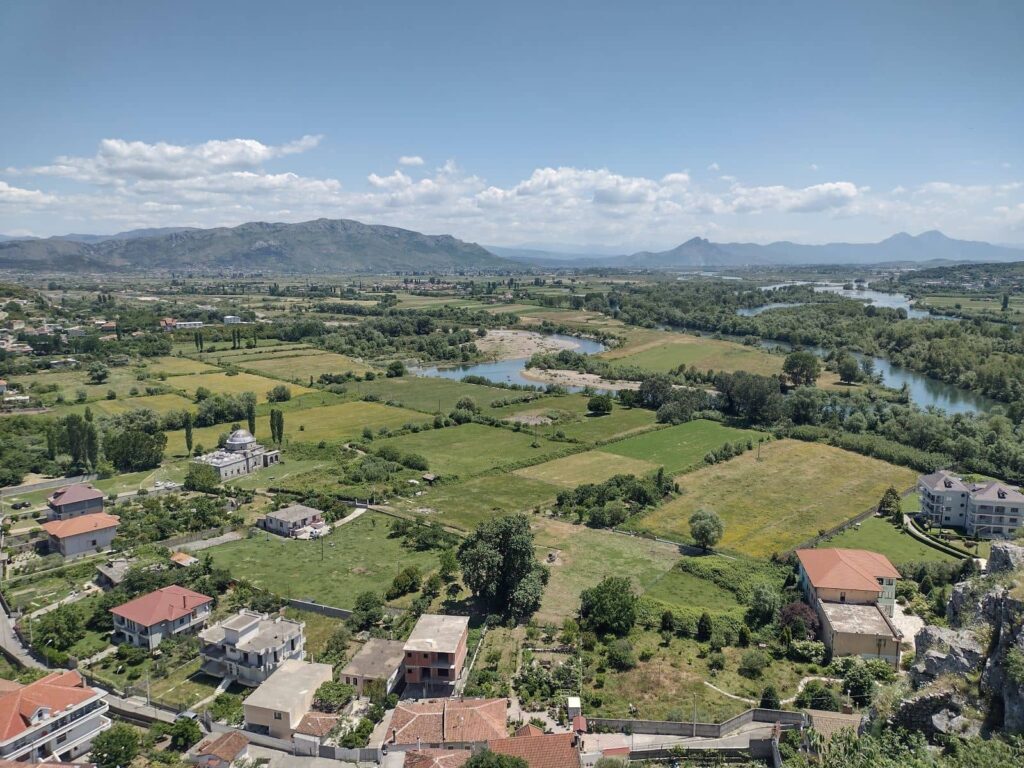
The gateway to Albania in the north, Shkoder, has slowly grown on me since my last visit. If you’re coming by bus from Montenegro, (especially Ulcinj) you’ll find yourself in this chilled-out city.
The first thing you’ll notice in Shkoder is the rather large number of bicyclists. It’s the preferred form of travel and a perfect way to explore some of the fun highlights around Shkoder.
Rozafa Castle stands at the edge of the city and has picture-perfect views of Shkodra Lake. While the castle doesn’t offer the same epicness as some other castles throughout Albania, the size of it is impressive nevertheless. It also gives a 360° view of the lands, including Montenegro and the meeting of Buna River and Drini River.
Along the deep blue waters of Shkodra Lake, you’ll find the sleepy fishing towns of Shiroka and Zogaj. They are a wonderful day trip from the city and offer restaurants with tasty fish and an escape from the hustle and bustle of a city.
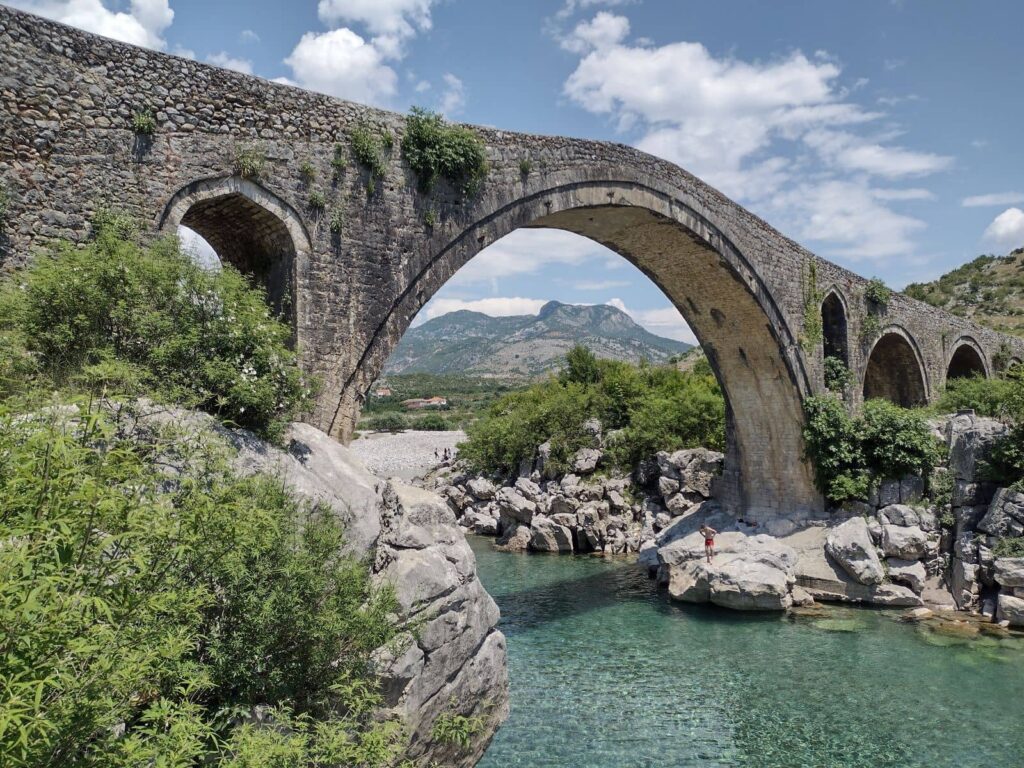
To the north of Shkoder, you’ll find the stunning Mesi Bridge. It’s an Ottoman-era stone bridge that towers over vibrant turquoise waters. In the Spring and early summer when the river runs high enough, it becomes packed with swimmers trying to beat the heat.
But, the real reason travelers stop by “The capital of Northern Albania” is its access to the famed Theth – Valbona hike. Tours and access to the mountains in the region start and end in Shkoder and are sold at almost every hotel and hostel.
While you’re waiting to explore Albania’s nature, enjoy the mouth-watering food and traverse the charming city center full of shops and cafes.
Theth | A True Mountain Town
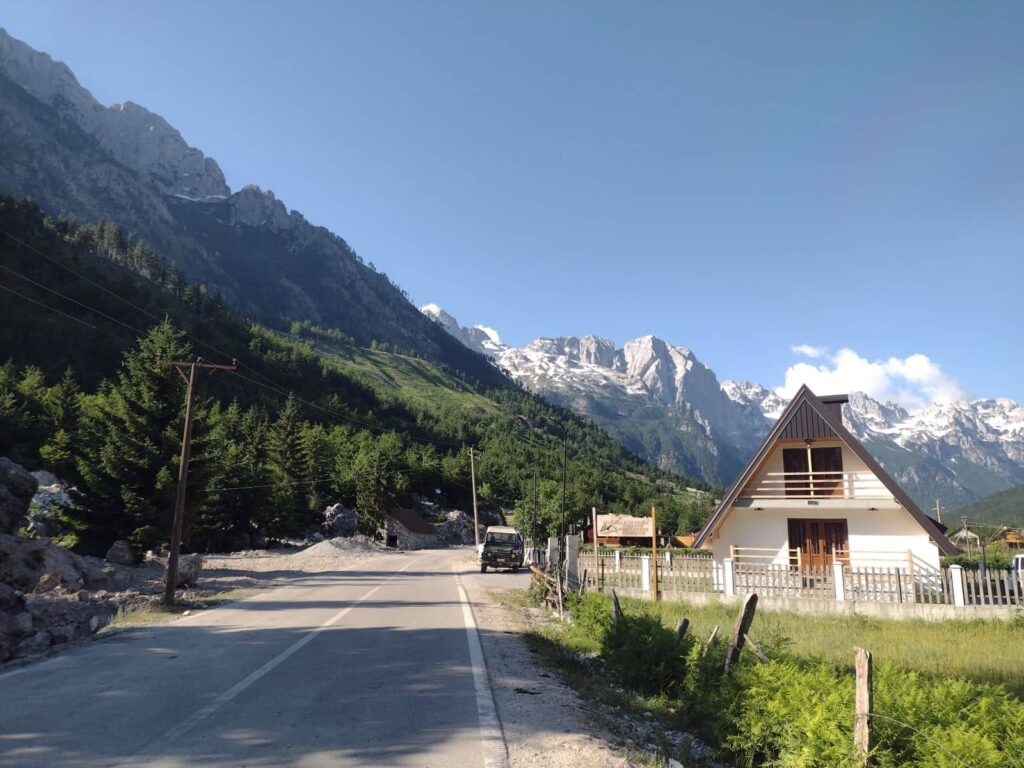
The Theth – Valbona trail is rapidly becoming one of the coolest day hikes in Europe. However, most travelers spend just a night in the mountain village and that’s a huge mistake!

There’s so much to do in Theth, after all, it’s smack in the middle of crazy beautiful nature. You can take a dip into the brilliant Theth Blue Eye, a day hike into the Accursed Mountains, or explore the stunning Grunas Waterfall. The path to Theth’s waterfall will pale in comparison to the larger Theth – Valbona Trail, however, its refreshing waters will feel like a reward for conquering Albania’s popular hike.
Head to the Theth Church for beautiful sunset sights and at the end of the day chat with fellow going to/from Valbona!
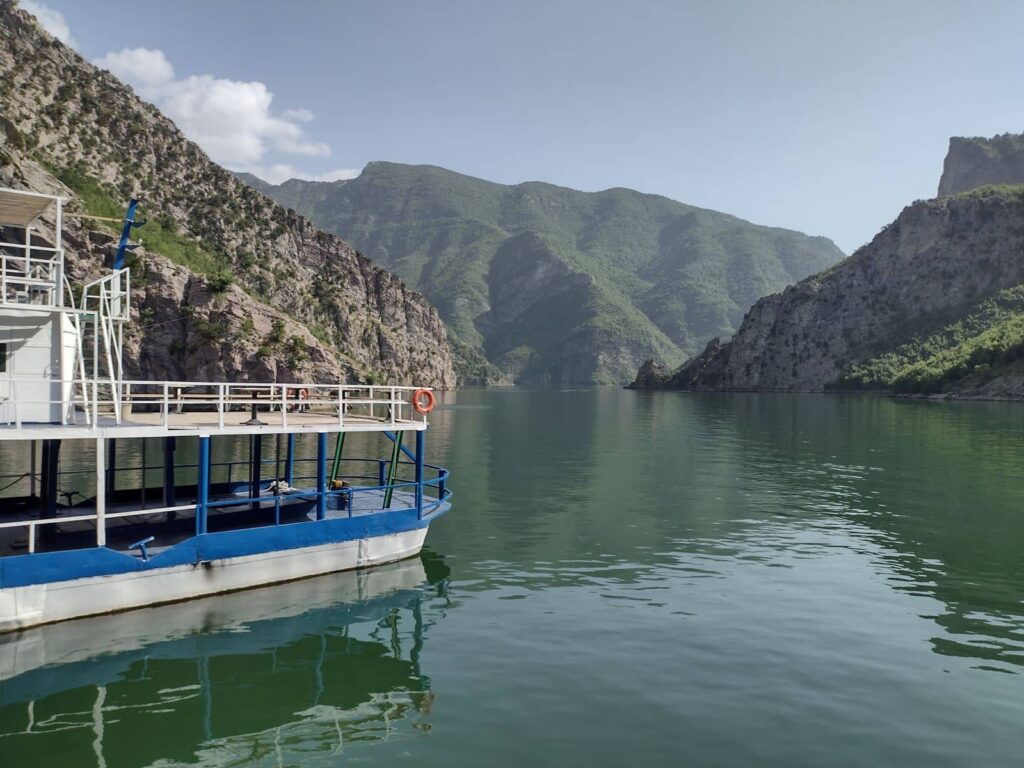
Whether you’re coming or going from Theth, you’ll undoubtedly find yourself passing between Valbona and Shkoder. The preferred route from one place to the other is a breathtaking boat ride across the shockingly green waters of Komani Lake. Here you’ll take the ferry through high-sloping canyon walls, slowly creeping the length of the lake.
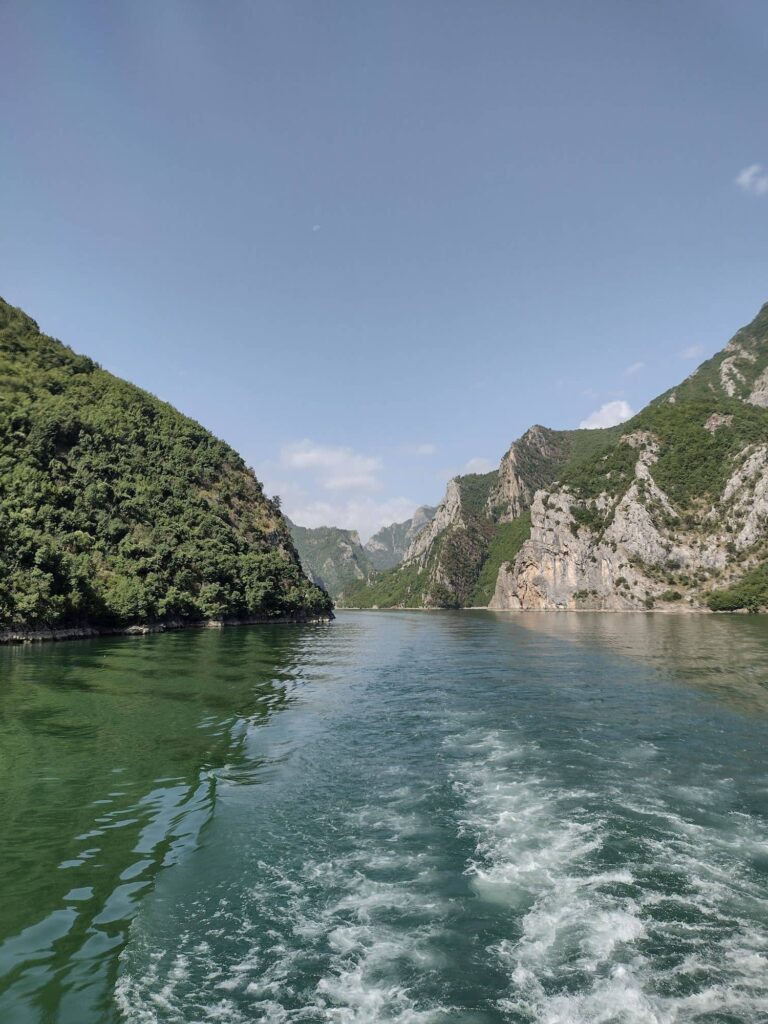

Kruja | A Historical Getaway
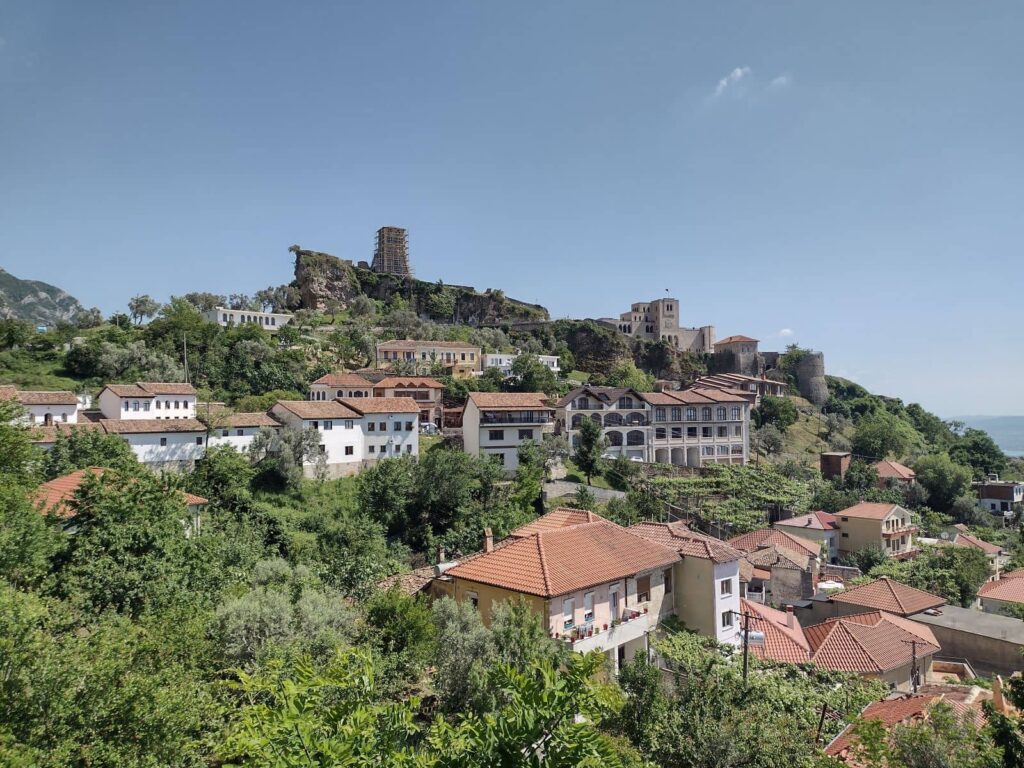
Kruja is a breathtaking little town that’s often treated as a day trip from Tirana. A short drive away from the capital, it has a magical feel and friendly people.
If you can afford the time, definitely spend a night in the historic town.
The Castle of Kruja is the main draw, housing tons of interesting spots inside the walls. Just underneath is the beautiful and modern Kruja Bazaar with picturesque shops full of unique souvenirs.
The castle is home to Skanderbeg Museum, one of Albania’s nicest museums. It tells the story of the country’s national hero Gjergj Kastrioti Skënderbeu.
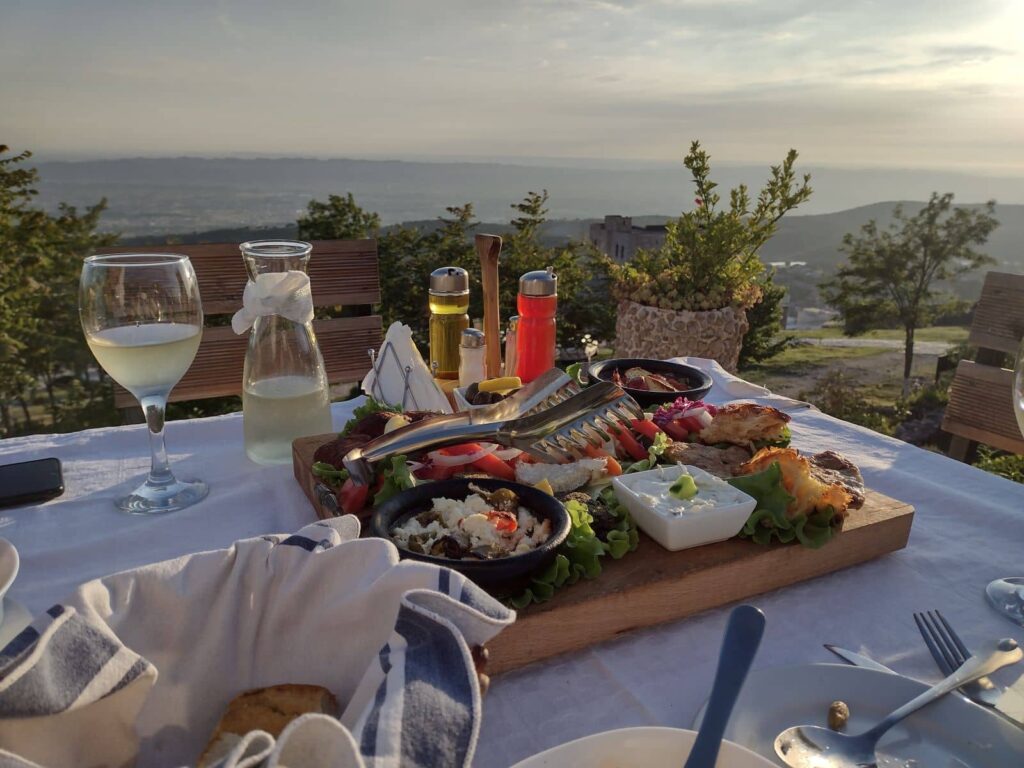
Across the courtyard, the Ethnographic Museum of Kruja gives great insight into the traditions and customs of Albanian people throughout the centuries. Also within the castle walls, you’ll find Rooms & Restaurant Emiliano. It’s a wonderful place to stay, with an amazing staff and spectacular home-cooked meals. Even if you don’t stay here, I suggest heading for a sunset dinner with one of the best views in all of Albania.
Durres | Beaches & Ruins
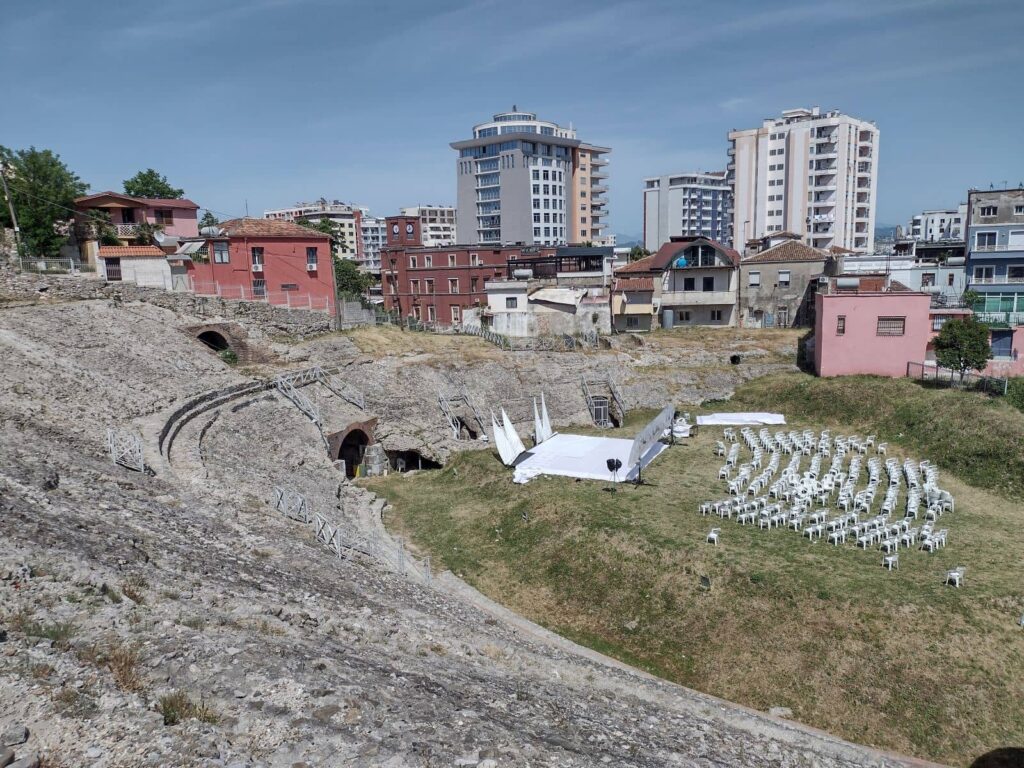
Durres is a beach resort town through and through. Tirana’s closest holiday getaway is packed full of tanning beds, seaside restaurants, and beachside fun.
The Beach of Durres is the main draw for locals. It’s a 10-kilometer stretch of sand, where cafes rule supreme and popcorn vendors set up their carts just inches from the water. Sunset walks by the water are all the rage and lights from the port and city center twinkle like the stars at dawn. Just past the port, you’ll find the popular Vollga Promenade with its Western-style restaurants and children’s carnival games.
If you’re looking for something a little more than “vacation life,” you can check out the city’s various historical sites. The Archaeological Museum of Durres hosts artifacts from the Greek, Hellenistic, and Roman periods. Remains of Durres Castle can be seen throughout the city, including its pristine Venetian Tower.
One of Europe’s most endangered cultural heritage sites, the Amphitheatre of Durres, also stands in the city center. It’s thought to be the Balkan Peninsula’s largest amphitheater and is on Albania’s tentative list of UNESCO World Heritage Sites.
Fier | A Visit to the Past

A colorful city with quiet charm, Fier is the place to stay when visiting the magnificent Apollonia Archaeological Park. Exploring the ancient ruins of Apollonia was one of my favorite moments while traveling in Albania.
The former Greek colony was a prominent settlement along the Mediterranean in its glory days, one well worthy of the god it was named after. If you spend an afternoon walking through the city’s hillside remnants, I think you’d agree. Especially after you notice the fragment of the Temple of Artemis!
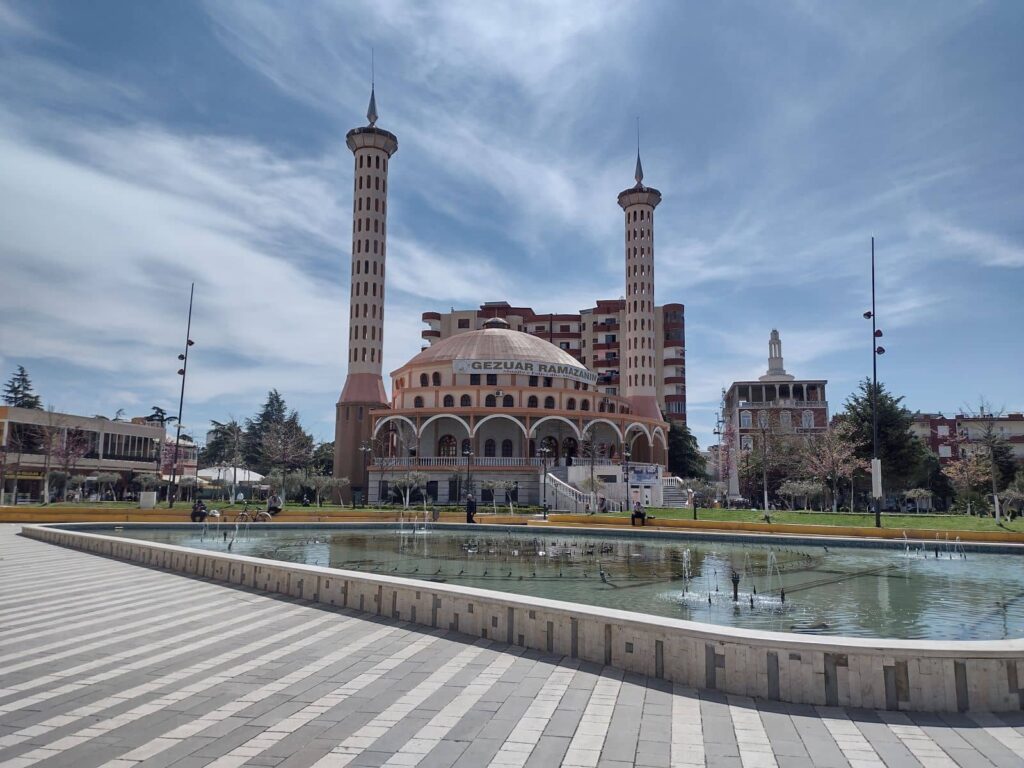
Fier is not only Apollonia though, it’s a delightful little city based around the Lumi i Gjanices (Gjanica River). Wandering along the river past the pretty Saint George Orthodox Cathedral is an excellent way to start the morning. Afterward, you can grab a börek for breakfast and head over to Park Qendror. The chilled-out park is a natural gathering point in Fier and the perfect place to have a snack and gather energy for a day of observing ruins.
Vlora | A Taste of Italy
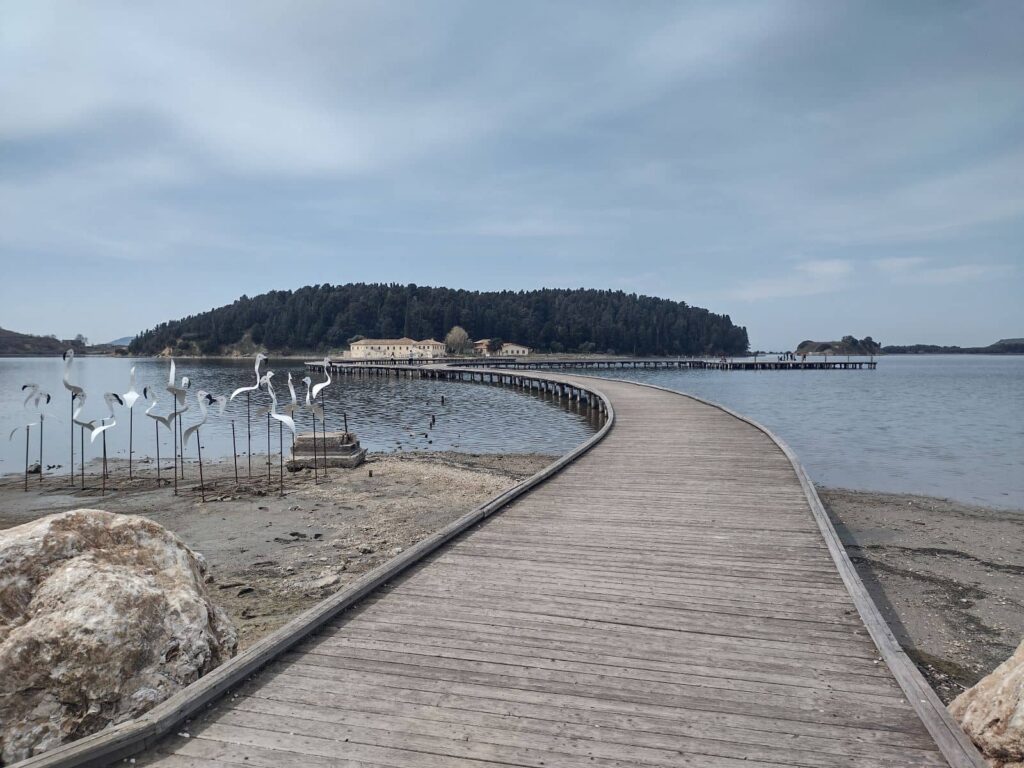
Known as an Italian getaway, Vlore is a beach resort city along the Albanian coast. Its long, wide beachfront is the perfect place to sunbathe during the day and catch a sunset at night.
From the Port of Vlora to Vlora Old Town the main streets are lined with nice restaurants, most of them focusing on a blend of Italian and Albanian food. Elevated above them all is the shrine of Kuzum Baba. The natural terrace offers fantastic views of the city, including the 16th-century Muradie Mosque. Vlora has another thing going for it; its proximity to some amazing places. The Narta Lagoon, a popular birdwatching area, lies to the north. Within its boundary, the historic Zvernec Monastery can be accessed by a bridge. The Byzantine-era monastery is nestled between pine trees and houses lovely paintings, intricate woodworking, and an up-close view of the lagoon’s colony of flamingos.

On Vlora’s southern outskirts, you’ll find the Castle of Kanina’s wreckage perched atop a craggy hill. The former settlement of the Amantes tribal community went through a few centuries worth of different rulers. Possessed by the Byzantines, Ottomans, and more, the castle has weathered multiple bombings. However, it still holds up to this day and boasts picturesque views of Vlora and the Albanian coast.
Vlora is also the northernmost city along the Albanian Riviera and the gateway to the scenic Llogara National Park. This makes it the ideal starting point when visiting the Riviera’s other dazzling towns and villages!
Himara | A Charming Beach Town
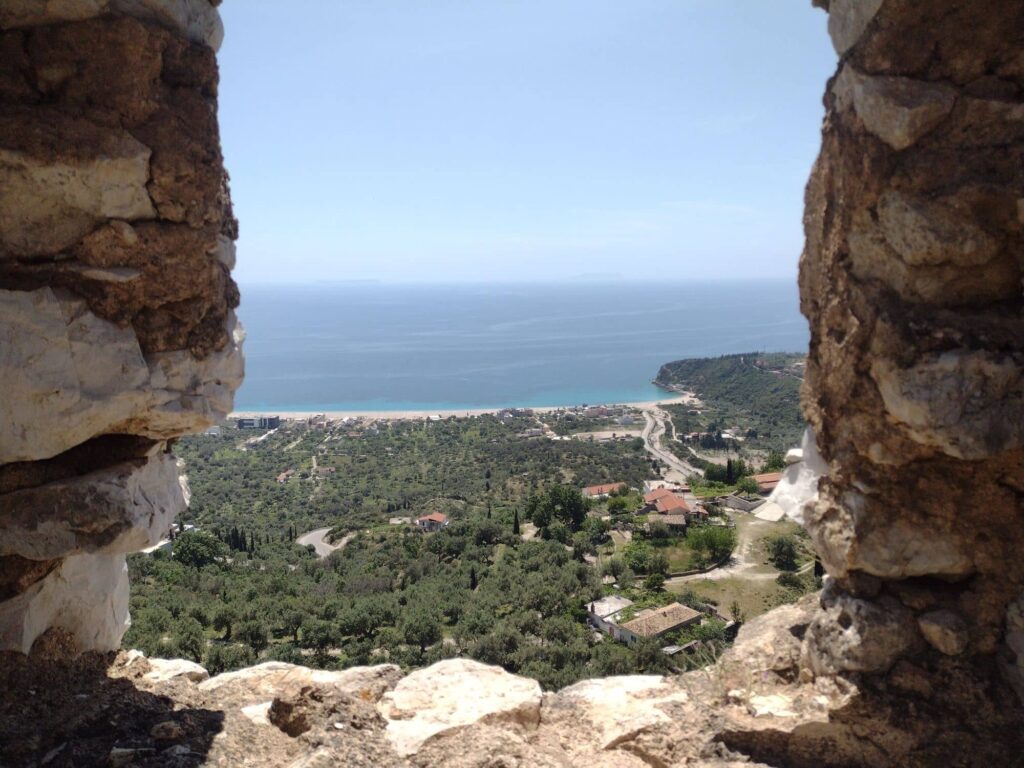
Himara is the Albanian Riviera’s coolest town, at least that’s what I think. With a quaint historic center, brilliant sand beaches, and plenty of sights to keep you busy, it’s got something for everyone. Enchanting seaside restaurants line the coast, while rugged cliffs form the town’s backdrop.
Himara’s second area is the more modern beachside village near its docks. The main promenade is a perfect place to experience “xhiro” as the chromatic sunsets lure you outside every evening.
It’s home to two uniquely different sections…although both give off laid-back Greek vibes. The first is the dilapidated old town. It’s home to various vintage buildings-turned-accommodations and the picturesque Himara Castle. The castle is a mess of stone buildings overrun with the tangled branches of trees. However, the panoramic views of Livadhi Beach’s turquoise waters and the green olive trees that dot the hillside are a must-see.
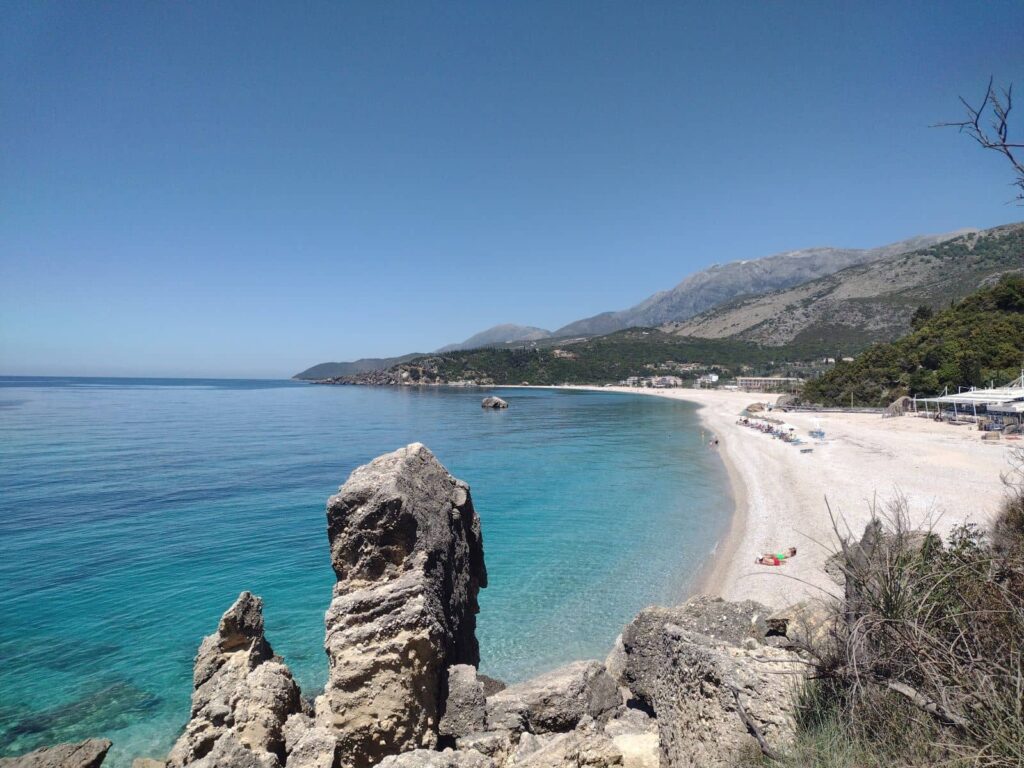
A quick and inexpensive furgon ride away from Himara is the prominent Porto Palermo Castle.
The castle stands by itself on a tiny fortified island that connects to land by a thin strip of beach. Here you will roam freely through the castle grounds, peeking in and out of rooms, including a creepy dungeon. From the rooftop, you’ll notice a few tiny Greek Islands on the horizon, along with a submarine bunker and a peninsula to your north.
When all is said and done though, Himara is a destination known for its beaches. Besides the main stretches running in front of houses and restaurants, there are several hidden sand coves. Hiking down to the concealed Filikuri Beach is an exhilarating experience, and the path from Livadhi Beach to Jala offers quiet spots. Among those is the tiny lounging area and swaying waters of Aquarium Beach.
Can a lazy beach town offer so much? Yes, it can!
A MORE DETAILED ARTICLE ABOUT HIMARA:
Dhermi | The Land Of Sunsets
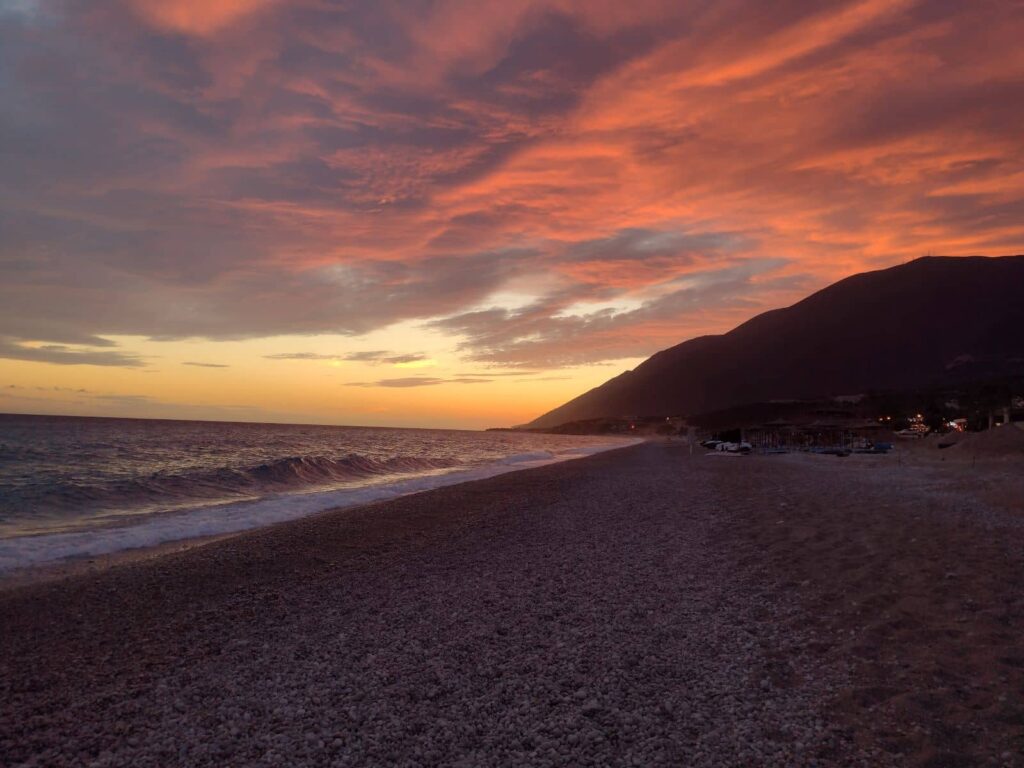
Dhermi is a tiny beach town close to Himara in both distance and style. Like its neighbor, its main draw is its beaches, in which two are within close walking distance. One of those is the gorgeous Drymades Beach and the other is the almost equally as beautiful Dhermi Beach.
Drymades Beach consistently comes up in discussions about Albania’s best beach, and rightfully so. Although restaurants and bars line the majority of the waterfront, there’s still a rugged feel about it. On the northern side, you’ll find a jumble of hidden coves behind its signature archway. Climbing the rough rocks and finding all their secluded nooks was one of my favorite things about Dhermi.
Dhermi Beach, on the other hand, lacks all the intricate little coves. However, it still manages to be an amazing swimming spot and equally as impressive for sunset! Delightful restaurants line its waterfront, making them an ideal stop between beach time and the trek uphill to the guest houses.
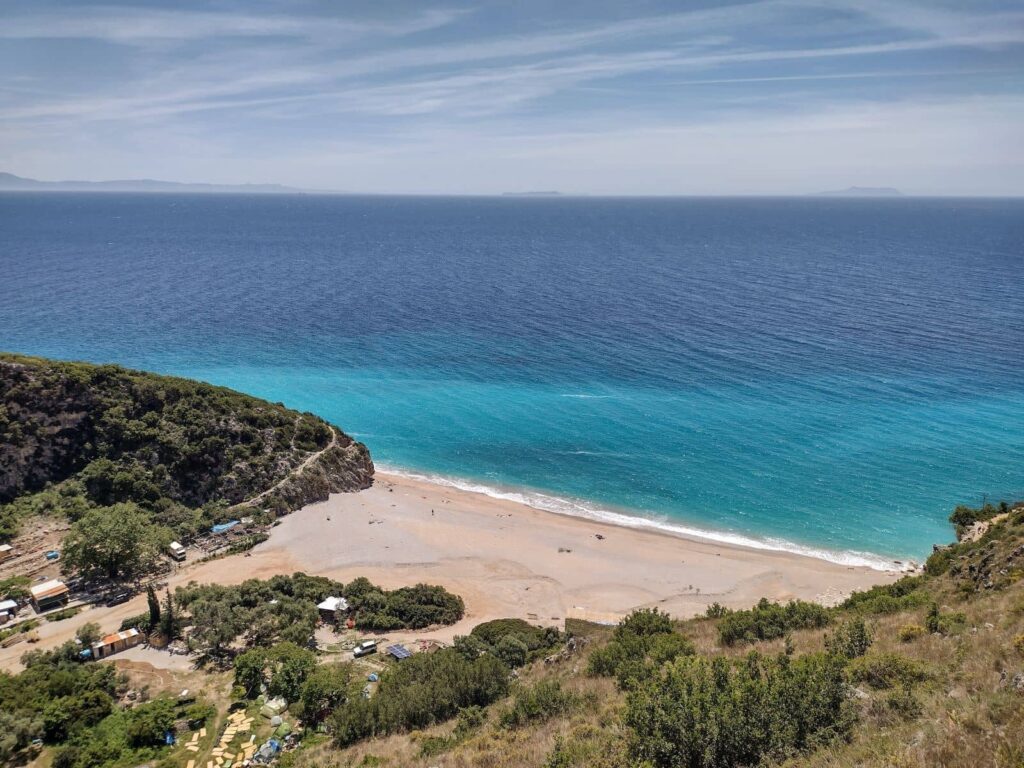
Even though the beaches were special, the highlight of my Dhermi trip was Gjipe Canyon and Beach. Smack between Dhermi and Himara, Gjipe feels utterly isolated. It’s a spectacular sand beach, sitting at the end of an expansive canyon, with dramatic ridges and eye-popping viewpoints. You can wild camp for the night if you want to, or rent kayaks and explore the clear blue waters.
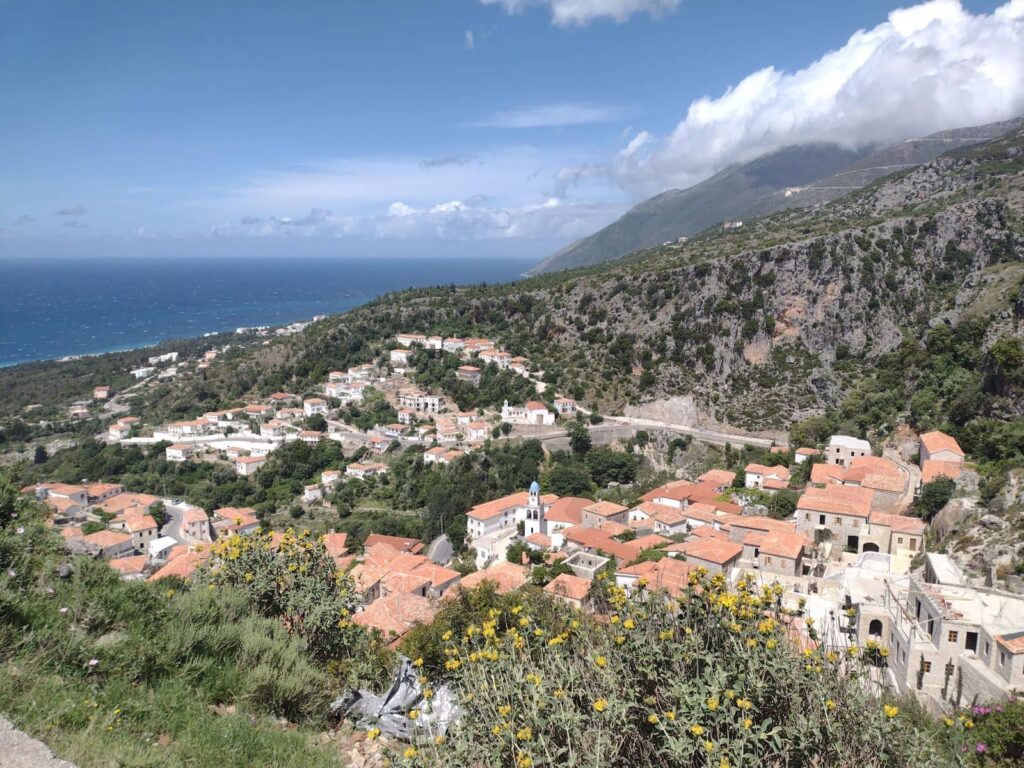
Despite the boundless attractiveness of Dhermi’s beaches, I constantly found myself drawn to its photogenic old town. Dhermi Old Town is a cluster of burnt orange rooftops, stone churches, and steep stairways. It’s a tiring trek, but the jaw-dropping scenery you’ll see from the Church of Saint Mary is worth the trip as well.
At the foot of Dhermi’s old town, you’ll find a wonderful trail that heads down to Dhermi Beach. The Mill’s Trail is its name and it will take you through the old mills while teaching you a bit about the village’s history. There’s also a small, but very pretty waterfall along the route!
A MORE DETAILED ARTICLE ABOUT DHERMI:
Saranda | The Go to Resort In Southern Albania
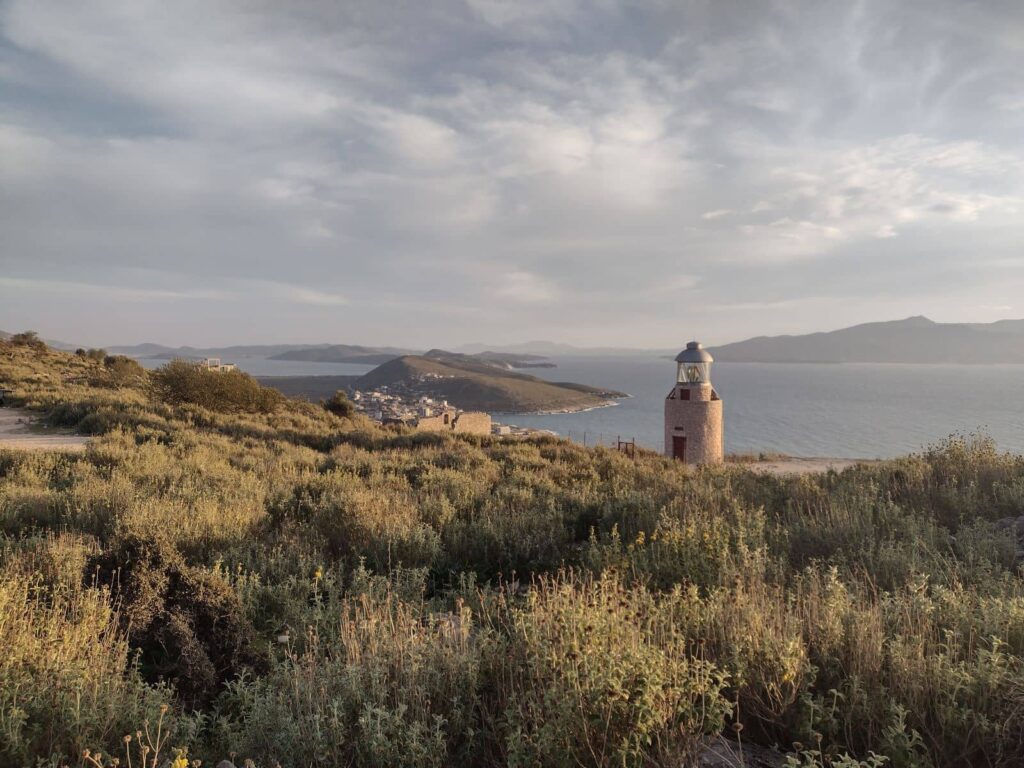
One of the Albanian Riviera’s favorite resort cities, Saranda has plenty to offer. Its main promenade the Saranda Embankment is buzzing with energy and chock-full of restaurants selling the day’s fresh catch. The beaches along the rocky shores are varied and an excellent way to beat the heat in summer. Oh, and there are marvelous views of the Greek island of Corfu from almost everywhere!
The best spots to find them? The city’s imposing castle and a hilltop monastery are in ruins.
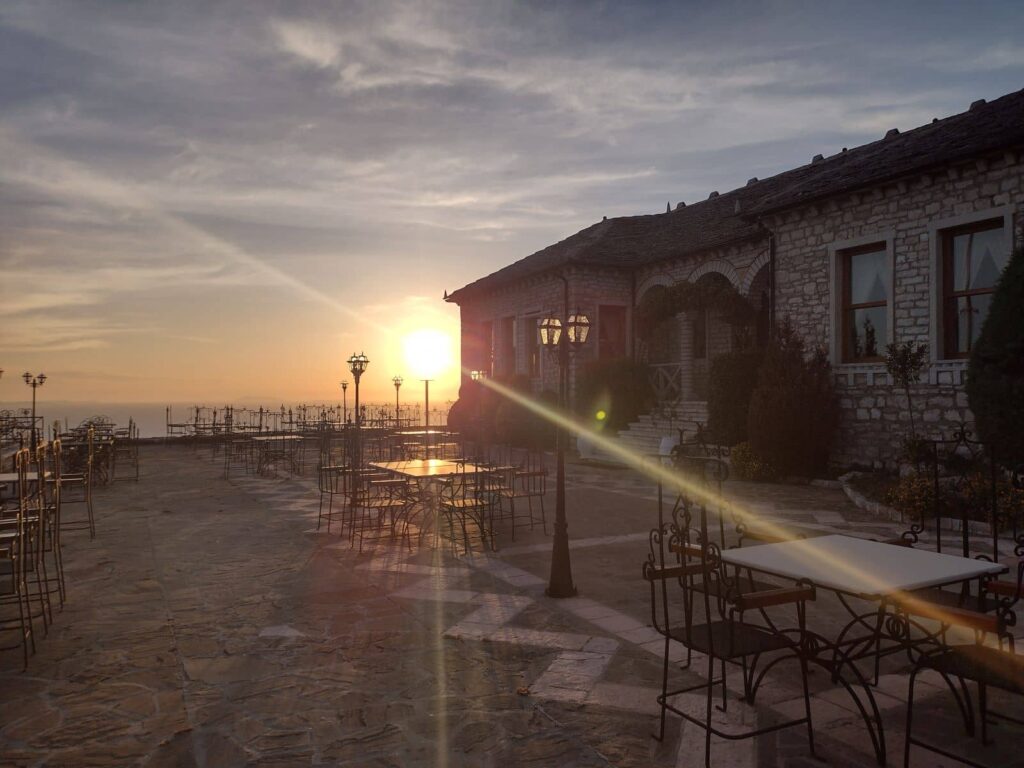
Lekuresi Castle has a 360° lookout, with farmland to the east, northern Corfu to the west, the city center to the north, and Albanian coastline to mainland Greece in the south. Bring some drinks and snacks up with you and enjoy a sublime sunset from the castle walls. The Monastery of the 40 Saints is located on the hill adjacent to the castle. It was an important pilgrimage sight during the Byzantine times and worth the hike up.
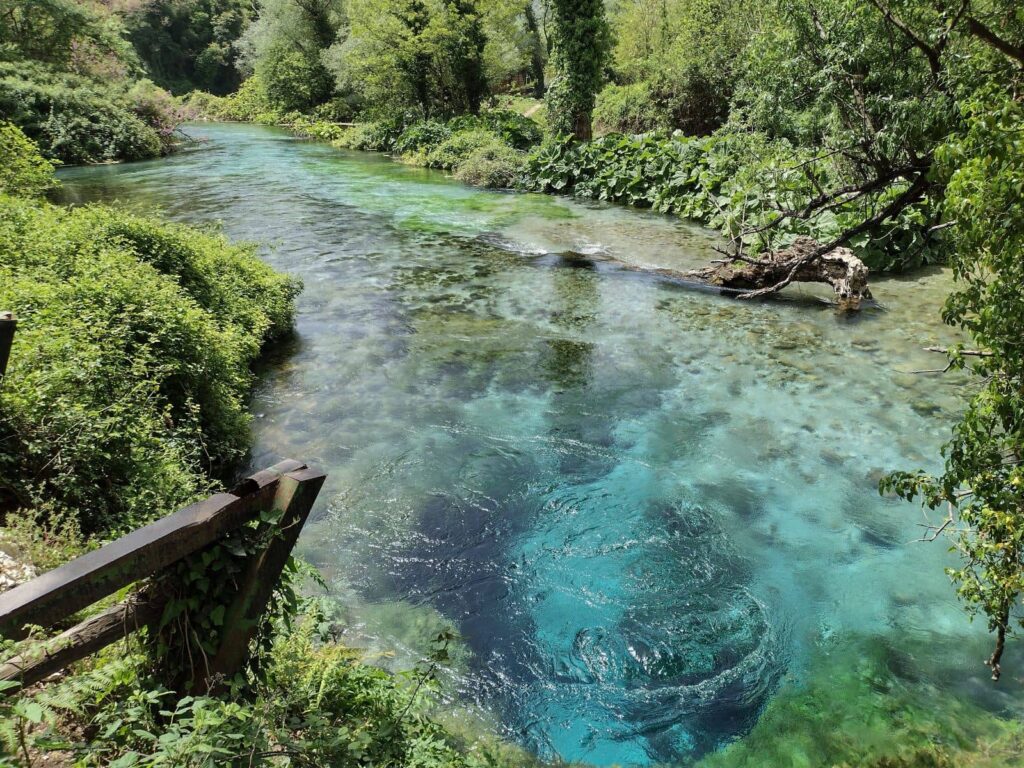
Besides a ferry ride to Corfu, there are some fun day trips to do in Saranda. The Blue Eye and its icy cold, hypnotic waters are a short bus ride away. The natural spring is a must-visit in southern Albania and a beautiful way to spend an afternoon.
You’ll also have to go through Saranda to get to the next place on the list…
Ksamil | History Meets Beaches
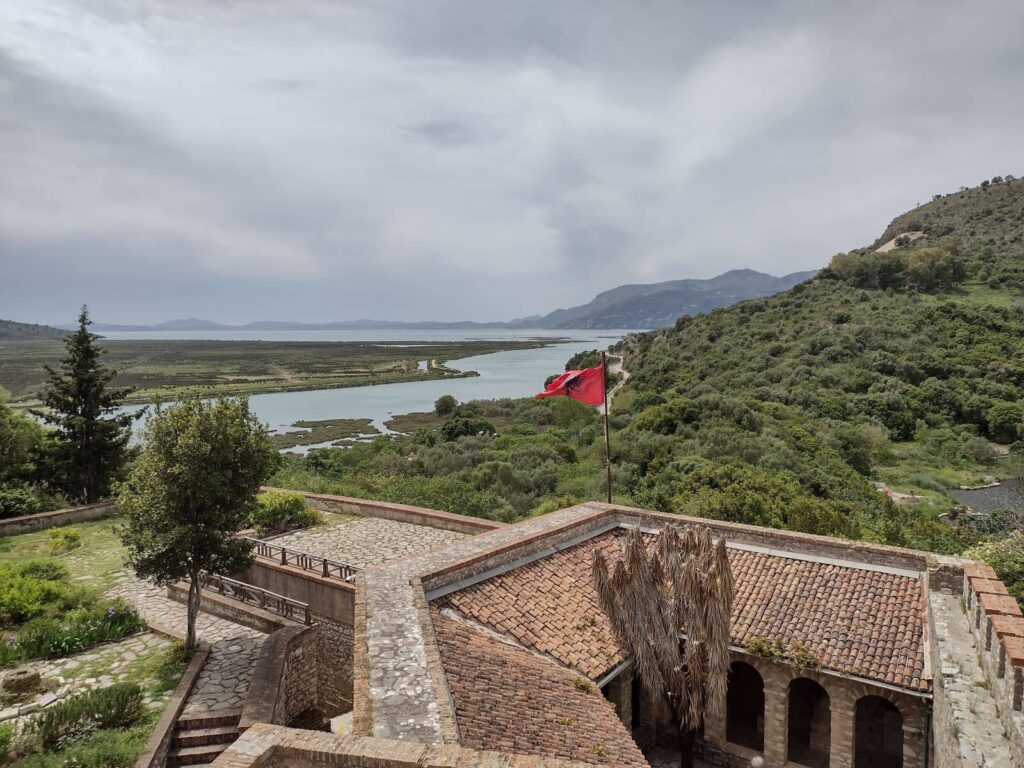
Just south of Saranda, you’ll find the bustling village of Ksamil. There are many, many beaches in the village’s vicinity. It’s also the gateway to the country’s beloved UNESCO-approved Butrint National Park.
Butrint’s ruins are from an ancient Greek and later Roman city that flourished in its prime. I spent a whole day roaming through the national park, learning its compelling history, and generally staring in awe at its beauty. A trip to the Greek part of Albania isn’t complete without viewing the important archeological site.
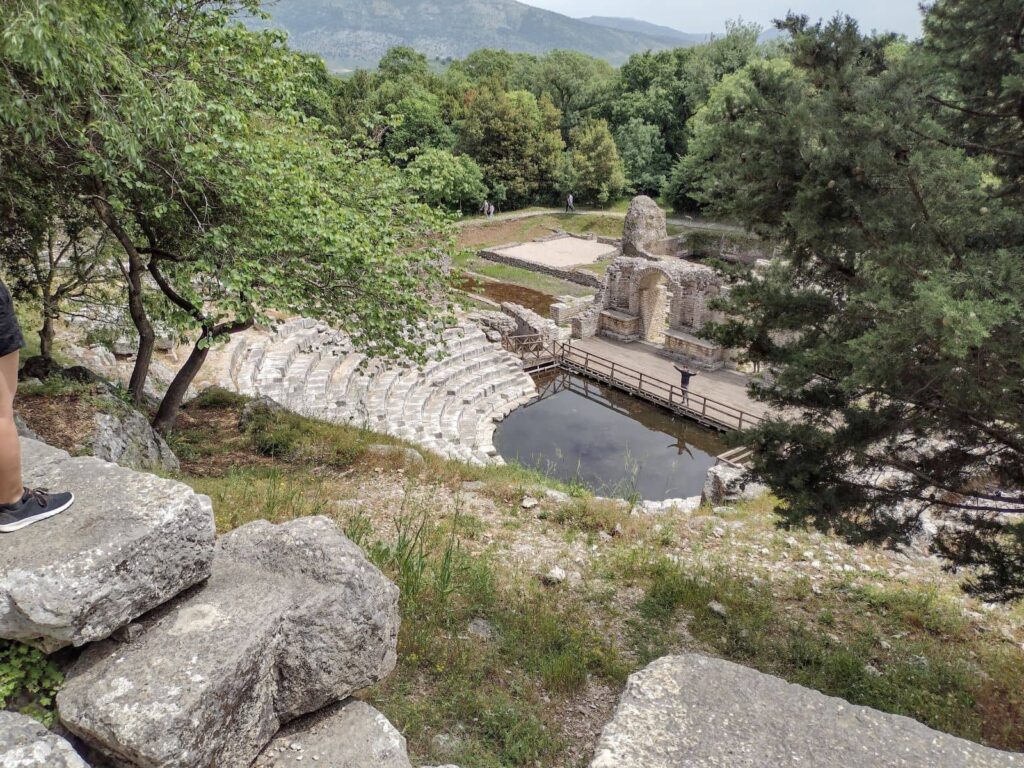
Just around the corner, you’ll find the mysterious Ali Pasha’s Castle on a small island, as well as a Forgotten House with even more views of Corfu.
The Four Islands are Ksamil’s main beach hub and attract flocks of beachgoers every summer. Their bright sands, aquamarine waters, and easy access make them a heavenly retreat. For a quieter retreat, walk the coastal trails and find the more secluded shores.
SOME MORE ARTICLES ABOUT KSAMIL:
Berat | The City of a Thousand Windows
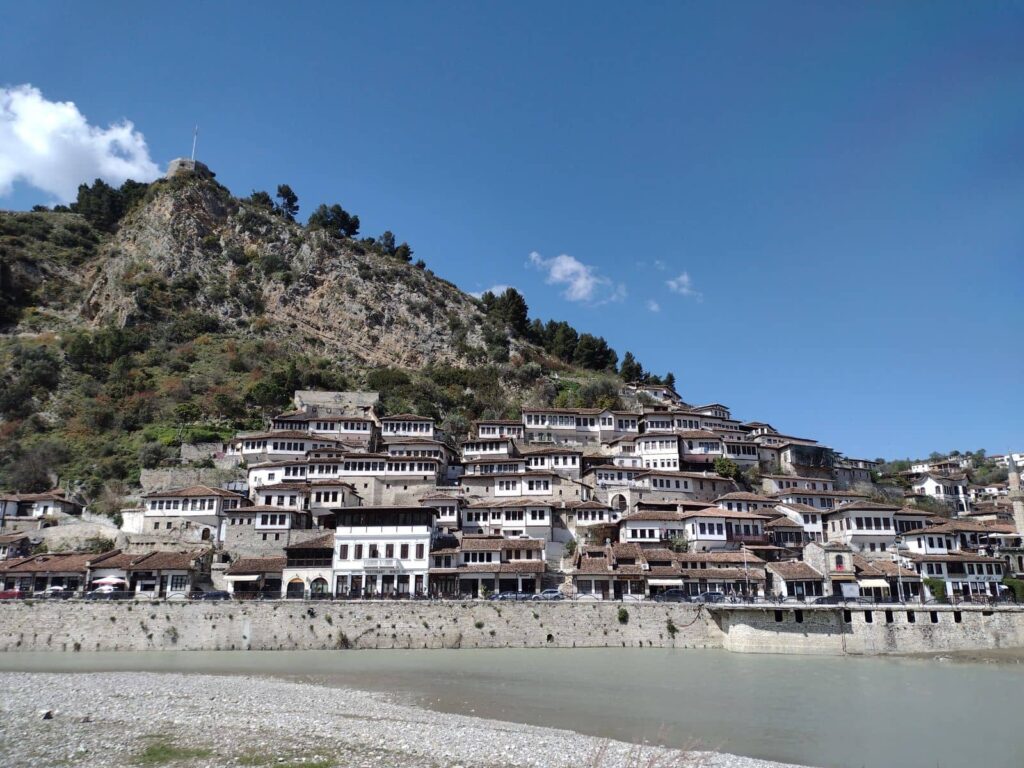
Berat is a picture-perfect city in central Albania with an extensive castle complex and a designated UNESCO historic center. Its striking Ottoman-era homes bestow upon it the name “The City of a Thousand Windows.” On both sides of the dazzling Osumi River, you’ll find the homes neatly climbing the neighboring hills. They are filled with adorable shops, cozy accommodations, and restaurants that have some of the best food in the country.
Along the northern embankment, in Berat’s Mangalem Quarter, you’ll walk through cobbled streets shaded by hanging grapevines. The district is directly beneath the imposing Berat Castle, a still liveable fortress with various churches and landmarks. The most popular of those is the photogenic Byzantine era Holy Trinity Church. Its well-preserved stonework and cross-domed roof truly emphasize the architecture of its time.
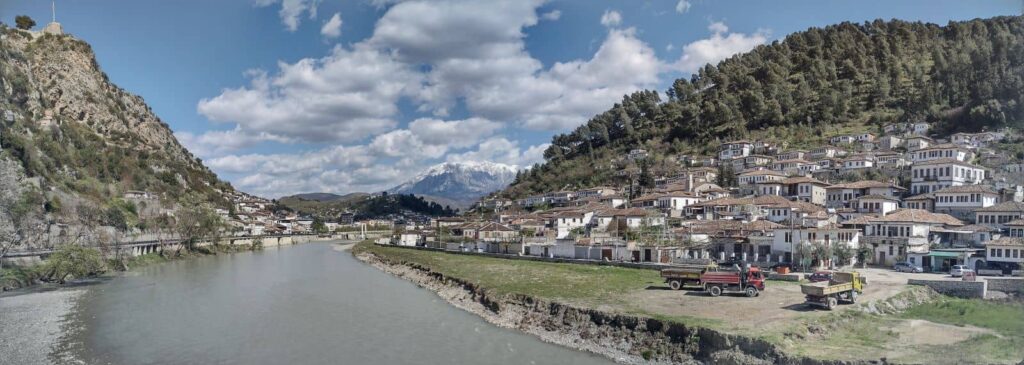
On the opposite bank, you’ll find the smaller, more relaxing Gorica Quarter. Like its twin, it’s teeming with restaurants, lodging, and churches. Above it, you’ll find a hiking trail leading to olive orchards, farmland, and the decaying Gorica Ruins. While the ruins won’t wow you like the Berat Castle, they make up for it with a bird’s eye view of Berat.
During the warmer months, it’s possible to make the journey to both Osumi Canyon and Bogova Waterfall. The canyon, dubbed “Albania’s Grand Canyon” is mesmerizing to hike through. The brilliant vertical cliffs and blue-green waters are one of the country’s top natural attractions. A trip to the exotic waterfall also makes for an excellent outdoor adventure.
SOME MORE ARTICLES ABOUT BERAT:
Gjirokaster | The Stone City
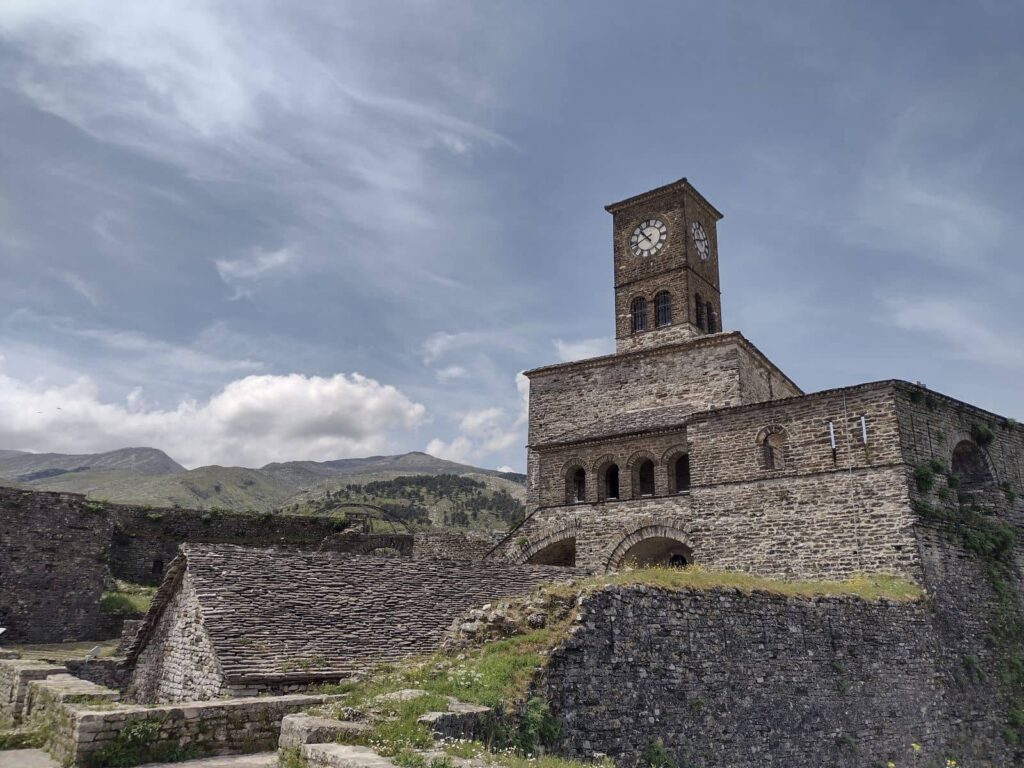
Recognized as “The Stone City,” Gjirokaster is Albania’s other UNESCO World Heritage city. It’s a labyrinth of stone slab steps and Ottoman-era homes on a steep, rugged hillside.
The first thing you’ll notice on arrival is the city’s medieval castle and its brilliant 18th-century clock tower. The Gjirokaster Castle is steeped in history, having a prominent role throughout Albania since the 6th century. Its open-air courtyard is home to an abandoned Lockheed T-33 jet and an aerial view of the mazelike Gjirokaster Bazaar.
The bazaar is an organized network of cobbled streets, antique souvenir shops, and aromatic eateries. Inside its territory, you’ll find a carved stone obelisk, an immaculate mosque, and loads of charm.
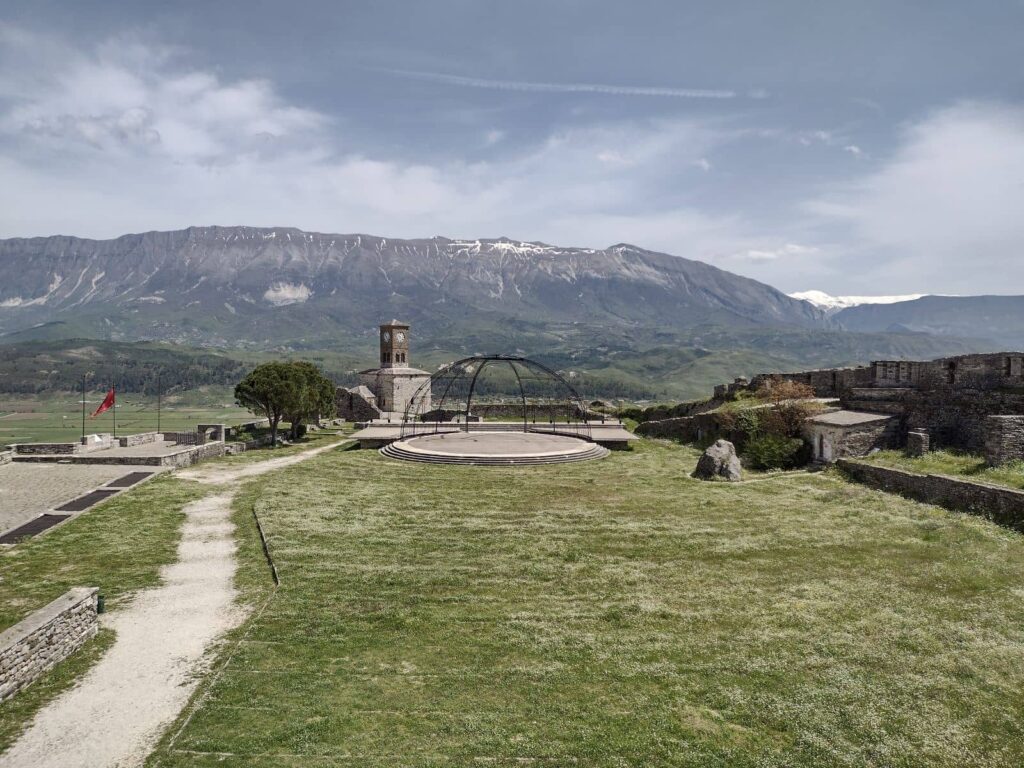
When you decide to wander Gjirokaster’s other memorable streets, you’ll have an array of other spots to choose from. The historic Skenduli House and Zekate House are an excellent start. As well-preserved Ottaman-era homes, a tour through either one is an immersive cultural experience that you should take. These homes are not only immensely intricate but also a great way to dive into Gjirokaster’s past.
If you’re looking for something that revolves more around Albania’s modern history, head to the tourist information center. You can ask them for a trip through the eerie Gjirokaster’s Cold War Tunnel. A guided tour gives a haunting, fascinating glimpse into the country’s prior communist days.
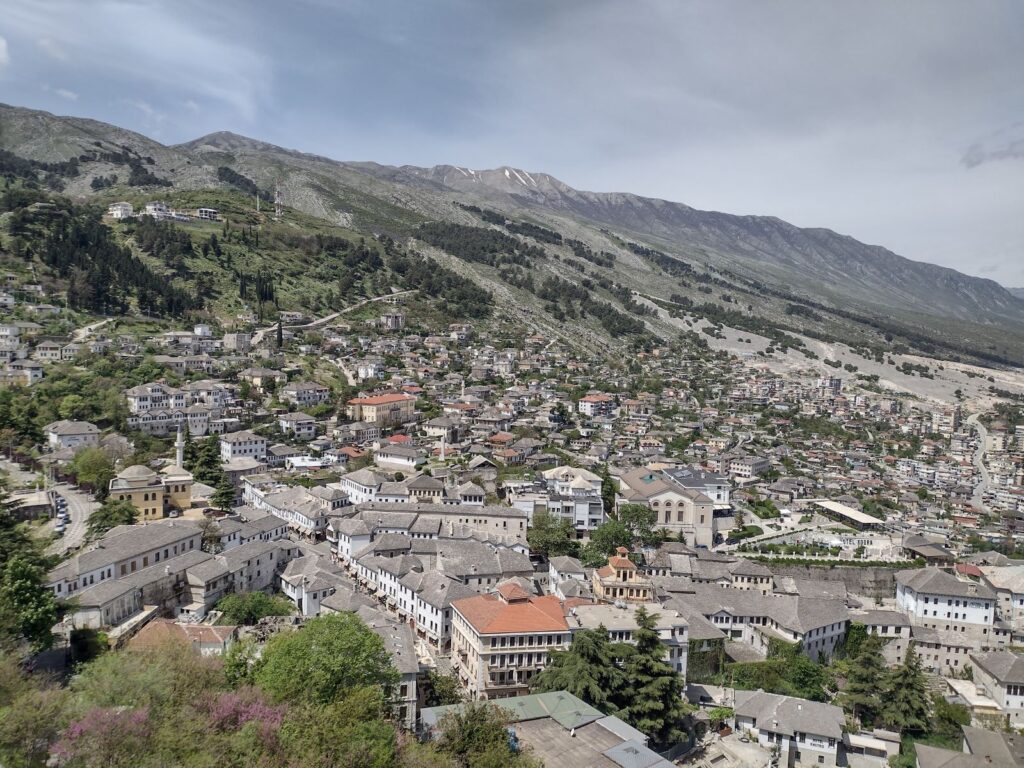
On the outskirts of the city, you’ll find the captivating Ali Pasha’s Bridge. Formerly part of an aqueduct system, the old bridge is a short but rewarding hike away. The valley below is a mishmash of rough stones, yellow wildflowers, and grazing mountain goats. If you’re there around sunset, you’ll have a chance to see the domesticated animals slowly crossing the bridge.
A MORE DETAILED POST ABOUT GJIROKASTER:











